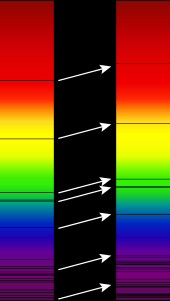
| General relativity |
|---|
 |
| Part of a series on |
| Physical cosmology |
|---|
 |
| Special relativity |
|---|
 |
In physics, a redshift is an increase in the wavelength, and corresponding decrease in the frequency and photon energy, of electromagnetic radiation (such as light). The opposite change, a decrease in wavelength and increase in frequency and energy, is known as a blueshift, or negative redshift. The terms derive from the colours red and blue which form the extremes of the visible light spectrum. The main causes of electromagnetic redshift in astronomy and cosmology are the relative motions of radiation sources, which give rise to the relativistic Doppler effect, and gravitational potentials, which gravitationally redshift escaping radiation. All sufficiently distant light sources show cosmological redshift corresponding to recession speeds proportional to their distances from Earth, a fact known as Hubble's law that implies the universe is expanding.
All redshifts can be understood under the umbrella of frame transformation laws. Gravitational waves, which also travel at the speed of light, are subject to the same redshift phenomena.[1] The value of a redshift is often denoted by the letter z, corresponding to the fractional change in wavelength (positive for redshifts, negative for blueshifts), and by the wavelength ratio 1 + z (which is greater than 1 for redshifts and less than 1 for blueshifts).
Examples of strong redshifting are a gamma ray perceived as an X-ray, or initially visible light perceived as radio waves. Subtler redshifts are seen in the spectroscopic observations of astronomical objects, and are used in terrestrial technologies such as Doppler radar and radar guns.
Other physical processes exist that can lead to a shift in the frequency of electromagnetic radiation, including scattering and optical effects; however, the resulting changes are distinguishable from (astronomical) redshift and are not generally referred to as such (see section on physical optics and radiative transfer).
- ^ Ding, Qianhang (August 2021). "Detectability of primordial black hole binaries at high redshift". Physical Review D. 104 (4). id. 043527. arXiv:2011.13643. Bibcode:2021PhRvD.104d3527D. doi:10.1103/PhysRevD.104.043527.
